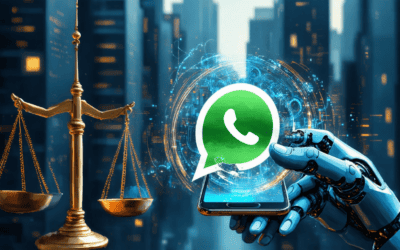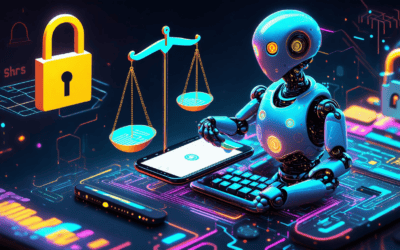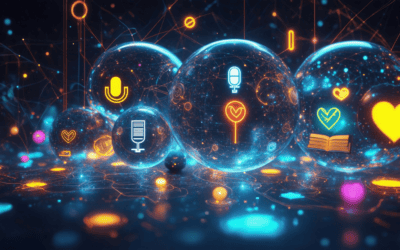In today’s fast-paced digital landscape, chatbots in digital marketing are emerging as transformative tools that are revolutionizing customer engagement and advertising strategies. As businesses strive to enhance their interactions with consumers, understanding what a chatbot in digital marketing entails becomes essential. This article will delve into the various types of chatbots, their significance in marketing, and real-world examples that illustrate their effectiveness. We will explore how to leverage chatbots for marketing and discuss best practices for implementing a successful chatbot marketing strategy. Additionally, we will examine the role of chatbots as marketing tools and their impact on customer experience. Join us as we uncover the importance of chatbots in digital marketing and the innovative trends shaping their future.
What is a chatbot in digital marketing?
A chatbot in digital marketing is an advanced tool that utilizes artificial intelligence (AI) and natural language processing (NLP) to facilitate automated conversations with users. These chatbots serve multiple purposes, including:
- Lead Generation: Chatbots can engage website visitors in real-time, capturing their information and qualifying leads through interactive dialogues. According to a study by HubSpot, businesses that use chatbots can increase lead generation by up to 50%.
- Customer Engagement: By providing instant responses to inquiries, chatbots enhance user experience and keep potential customers engaged. Research indicates that 64% of internet users view 24-hour service as the best feature of chatbots.
- Conversion Optimization: Chatbots can guide users through the sales funnel by offering personalized recommendations and addressing objections, which can lead to higher conversion rates. A report from Intercom found that businesses using chatbots saw a 30% increase in conversion rates.
- Customer Support: Chatbots can handle common customer queries, reducing the workload on human agents and providing immediate assistance. According to a study by Gartner, by 2022, 70% of customer interactions will involve emerging technologies such as chatbots.
- Data Collection and Analysis: Chatbots can gather valuable data on customer preferences and behaviors, allowing businesses to refine their marketing strategies. This data-driven approach enables more targeted marketing efforts and improved customer insights.
Incorporating chatbots in marketing strategies not only streamlines operations but also enhances customer satisfaction and loyalty. As technology evolves, the capabilities of chatbots continue to expand, making them an essential component of modern marketing efforts.
Understanding the Basics of Chatbots in Marketing
Chatbots have become a cornerstone in the realm of chatbots marketing, offering businesses a way to interact with customers efficiently. These digital assistants can be integrated into various platforms, including websites and social media, to provide seamless communication. The primary function of a marketing chatbot is to simulate human conversation, allowing for personalized interactions that can lead to increased customer satisfaction.
Moreover, chatbots can be programmed to handle a variety of tasks, from answering frequently asked questions to guiding users through complex processes. This versatility makes them invaluable for businesses looking to enhance their customer engagement and streamline their operations. By utilizing a chatbot for marketing, companies can ensure that they are available to their customers around the clock, thus improving overall service quality.
Importance of Chatbots in Digital Marketing
The importance of chatbots in digital marketing cannot be overstated. They not only improve operational efficiency but also significantly enhance the customer experience. Here are some key reasons why chatbots are essential:
- 24/7 Availability: Chatbots provide round-the-clock service, ensuring that customer inquiries are addressed promptly, regardless of the time of day.
- Cost Efficiency: By automating responses to common queries, businesses can reduce the need for extensive customer service teams, leading to lower operational costs.
- Enhanced User Experience: With instant responses and personalized interactions, chatbots contribute to a more satisfying customer journey.
- Scalability: As businesses grow, chatbots can easily scale to handle increased customer interactions without the need for additional resources.
In conclusion, the integration of chatbots for marketing is a strategic move that can lead to improved customer relationships and increased sales. As we continue to embrace digital transformation, the role of chatbots in marketing will only become more significant.

What are the four types of chatbots?
Understanding the different types of chatbots is essential for leveraging their capabilities in chatbots in digital marketing. Each type serves unique purposes and can enhance customer interactions in various ways. Here’s a closer look at the four primary types of chatbots used in marketing:
Exploring Different Types of Chatbots for Marketing
1. Rule-based Chatbots: These chatbots operate on predefined rules and scripts. They can only respond to specific commands and are limited in their ability to handle unexpected queries. They are best suited for straightforward tasks, such as FAQs or simple customer service inquiries.
2. Keyword Recognition-based Chatbots: Utilizing natural language processing (NLP), these chatbots identify keywords in user input. They can understand variations of questions but may struggle with complex sentences. They are effective for guiding users through a set of options based on recognized keywords.
3. Menu-based Chatbots: These chatbots provide users with a menu of options to choose from, simplifying interactions. They are ideal for structured tasks like booking appointments or ordering products, enhancing the user experience in chatbot marketing.
4. Contextual Chatbots (Intelligent Chatbots): These advanced chatbots leverage machine learning and AI to understand context and maintain conversations over multiple interactions. They can learn from user interactions, making them capable of providing personalized responses and improving over time.
Best Chatbots in Digital Marketing: A Comparative Overview
When considering the best chatbots for marketing, several platforms stand out due to their features and capabilities. For instance, Brain Pod AI offers a range of AI-driven solutions that enhance customer engagement through intelligent chatbots. Their AI chat assistant is particularly effective for businesses looking to streamline customer interactions.
Other notable options include Zendesk, known for its robust customer service tools, and Intercom, which excels in personalized messaging and user engagement strategies. Each of these platforms provides unique features that can be tailored to specific marketing needs, making them valuable assets in the realm of chatbots in marketing.
For more insights on how to effectively use chatbots in your marketing strategy, explore our resources on using chatbots for marketing.
What is a Chatbot and an Example?
A chatbot, also known as a chatterbot, is an advanced form of artificial intelligence (AI) designed to simulate human conversation through messaging applications or websites. These automated programs utilize natural language processing (NLP) to understand and respond to user inquiries, providing a seamless interaction experience. In the realm of chatbots in digital marketing, they serve as powerful tools for enhancing customer engagement and streamlining communication.
Real-World Chatbot Marketing Examples
Numerous brands have successfully integrated chatbots in marketing strategies to improve customer interaction and drive sales. For instance, Sephora employs a chatbot on its website and social media platforms to assist customers with product recommendations, appointment bookings, and answering FAQs. This not only enhances user experience but also increases conversion rates by providing immediate assistance.
Another notable example is H&M, which utilizes a chatbot to help customers navigate their online store, offering personalized outfit suggestions based on user preferences. This application of chatbot marketing showcases how brands can leverage AI to create tailored shopping experiences that resonate with consumers.
How to Use Chatbots in Digital Marketing Effectively
To maximize the effectiveness of chatbots for marketing, businesses should consider the following strategies:
- Define Clear Objectives: Establish what you want to achieve with your chatbot, whether it’s lead generation, customer support, or enhancing user engagement.
- Integrate with Existing Systems: Ensure your chatbot can seamlessly connect with your CRM and other marketing tools to provide a cohesive experience.
- Utilize AI Capabilities: Implement AI-powered chatbots that can learn from interactions and improve over time, making them more effective in handling diverse inquiries.
- Monitor Performance: Regularly analyze chatbot interactions and user feedback to refine its responses and enhance overall performance.
By effectively utilizing chatbots in digital marketing, brands can not only improve customer satisfaction but also drive sales and foster loyalty. For more insights on enhancing customer support with chatbots, check out our article on elevating customer support with conversational AI chatbots.
How to Use Chatbot for Advertising
Utilizing a chatbot in marketing can significantly enhance your advertising efforts. By integrating chatbots into your digital marketing strategy, you can create a more engaging and personalized experience for your customers. Here are some effective strategies to consider:
Chatbot Advertising Strategies for Enhanced Engagement
1. Identify Frequently Asked Questions (FAQs): Start by compiling a list of common inquiries your customers have. This will help you tailor your chatbot’s responses to address the most pressing concerns, enhancing user engagement and satisfaction. Research shows that addressing FAQs can improve customer experience by up to 80% (source: HubSpot).
2. Design Specific Conversation Flows: Create structured conversation paths that guide users through their interactions with the chatbot. Use decision trees to lead users to relevant information or products based on their responses. This approach not only streamlines the user experience but also increases conversion rates by providing personalized recommendations (source: Drift).
3. Conduct Regular Testing and Optimization: Continuously test your chatbot’s performance by analyzing user interactions and feedback. Use A/B testing to compare different conversation flows and identify which ones yield the best results. Regular updates based on user data can enhance the chatbot’s effectiveness and relevance (source: Chatbots Magazine).
4. Differentiating Your Chatbot: Ensure your chatbot has a unique personality and branding that aligns with your business. This can include using a friendly tone, incorporating humor, or utilizing visuals. A distinctive chatbot can enhance brand recognition and user retention (source: Forbes).
5. Obtain User Consent for Communication: Always ask for permission before sending promotional messages or updates. This not only complies with regulations like GDPR but also builds trust with your audience. Clear opt-in processes can increase engagement rates significantly (source: Mailchimp).
6. Collect User Data Responsibly: Use the chatbot to gather valuable insights about your customers, such as preferences and feedback. Ensure that you communicate how this data will be used and stored, maintaining transparency to foster trust (source: Data Protection Commission).
7. Promote Your Chatbot Across Channels: Actively promote your chatbot on your website, social media platforms, and email newsletters. Highlight its features and benefits to encourage users to engage. Cross-channel promotion can significantly increase user interaction and brand visibility (source: Social Media Examiner).
By implementing these strategies, businesses can effectively leverage chatbots for marketing, enhancing customer engagement and driving sales.
Using Chatbots for Marketing: Best Practices
To maximize the effectiveness of your chatbot marketing strategy, consider the following best practices:
1. Integrate with Existing Marketing Tools: Ensure your chatbot can seamlessly integrate with your existing marketing tools, such as CRM systems and email marketing platforms. This integration allows for a more cohesive marketing approach and better data management.
2. Utilize Analytics for Continuous Improvement: Leverage analytics tools to track user interactions and engagement metrics. This data can provide insights into user behavior, helping you refine your chatbot’s performance and improve overall customer experience.
3. Focus on User Experience: Always prioritize the user experience when designing your chatbot interactions. A well-designed chatbot should be intuitive, easy to navigate, and capable of providing quick and accurate responses to user inquiries.
4. Stay Updated with Trends: Keep abreast of the latest trends in chatbots in digital marketing. This includes advancements in AI technology and changes in consumer behavior, which can inform your chatbot’s functionality and marketing strategies.
5. Engage Users with Interactive Content: Incorporate interactive elements such as quizzes, polls, or games within your chatbot conversations. This can enhance user engagement and make interactions more enjoyable.
By following these best practices, you can effectively harness the power of chatbots in marketing to drive engagement and achieve your advertising goals.

Is a Chatbot a Marketing Tool?
Yes, a chatbot is indeed a powerful marketing tool. Chatbots are AI-driven software applications designed to simulate human conversation, engaging users through text or voice. They provide instant responses to inquiries, guide users through processes, and facilitate transactions, enhancing customer engagement and streamlining communication.
The Role of Chatbots as Marketing Tools
Chatbots play a crucial role in modern marketing strategies. Their ability to operate 24/7 ensures that customer queries are addressed at any time, significantly improving customer satisfaction and retention. According to HubSpot, this constant availability is a key factor in enhancing user experience. Additionally, chatbots contribute to cost efficiency by automating routine interactions, which can reduce operational costs associated with customer service personnel, as noted by Gartner.
Moreover, chatbots excel in lead generation. They can qualify leads by asking targeted questions and collecting user information, which can then be utilized for personalized marketing strategies, as highlighted by Drift. This capability not only streamlines the sales process but also enhances the overall user experience on websites and apps, as emphasized by Salesforce.
Advantages and Disadvantages of Chatbots Marketing Strategy
While the advantages of using chatbots in marketing are substantial, it’s essential to consider potential disadvantages as well. The benefits include:
- 24/7 Availability: Ensures customer queries are addressed at any time, enhancing satisfaction.
- Cost Efficiency: Reduces operational costs by automating routine interactions.
- Lead Generation: Qualifies leads through targeted questions and data collection.
- Enhanced User Experience: Provides instant responses, reducing wait times.
However, challenges may arise, such as:
- Limited Understanding: Chatbots may struggle with complex queries or nuanced conversations.
- Dependence on Technology: Over-reliance on chatbots can lead to a lack of personal touch in customer interactions.
In conclusion, while chatbots serve as essential marketing tools that enhance customer interaction and drive sales, businesses must balance automation with the need for human engagement. For more insights on implementing chatbots effectively, explore our guide on using chatbots for marketing.
What is the Role of Chatbots in Digital Marketing and Their Impact on Customer Engagement?
Chatbots have become an integral part of digital marketing, significantly enhancing customer engagement through various functionalities. Their role extends beyond simple interactions; they provide a comprehensive solution for businesses aiming to improve customer experience and streamline operations. Here are some key aspects of how chatbots contribute to digital marketing:
Importance of Chatbots in Digital Marketing Engagement
1. 24/7 Customer Support: Chatbots provide continuous support, ensuring that customer queries are addressed at any time of day. This availability significantly enhances user satisfaction and overall experience, as customers receive immediate responses without waiting for human agents.
2. Streamlined Customer Service: By efficiently handling routine inquiries, chatbots allow human customer service representatives to concentrate on more complex issues. This not only improves operational efficiency but also enhances the quality of service provided to customers.
3. Personalized Interactions: Advanced chatbots utilize artificial intelligence (AI) and machine learning algorithms to analyze customer data and preferences. This enables them to deliver personalized recommendations and responses, fostering a deeper connection with customers and improving engagement rates.
4. Lead Generation and Qualification: Chatbots can effectively engage website visitors, collect information, and qualify leads through interactive conversations. This process helps businesses identify potential customers and tailor their marketing strategies accordingly.
5. Cost Efficiency: Implementing chatbots can significantly reduce operational costs associated with customer service. According to a report by Juniper Research, chatbots are projected to save businesses over $8 billion annually by 2022 through improved efficiency and reduced staffing needs.
6. Data Collection and Insights: Chatbots gather valuable data on customer interactions, preferences, and behaviors. This information can be analyzed to gain insights into customer needs and trends, enabling businesses to refine their marketing strategies and improve product offerings.
7. Enhanced Customer Engagement: By providing instant responses and personalized experiences, chatbots increase customer engagement levels. Research from HubSpot indicates that 47% of consumers are open to buying items through a chatbot, highlighting their effectiveness in driving sales.
8. Integration with Other Marketing Tools: Chatbots can be seamlessly integrated with various digital marketing platforms, such as CRM systems and email marketing tools. This integration allows for a cohesive marketing strategy that enhances customer journey mapping and engagement.
Chatbots and Marketing: Enhancing Customer Experience
Chatbots are not just tools for customer service; they are pivotal in enhancing the overall customer experience in digital marketing. By leveraging chatbots, businesses can:
– Improve Response Times: Instantaneous responses to customer inquiries lead to higher satisfaction rates. Customers appreciate quick resolutions, which chatbots can provide without delay.
– Foster Brand Loyalty: Personalized interactions create a sense of connection between the brand and the customer. When customers feel understood and valued, they are more likely to return.
– Facilitate Seamless Transactions: Chatbots can guide customers through the purchasing process, making it easier for them to complete transactions. This capability is particularly beneficial in e-commerce settings.
In conclusion, the importance of chatbots in digital marketing cannot be overstated. They enhance customer engagement through personalized interactions, efficient service, and valuable insights, making them essential for any modern marketing strategy. For more insights on how to implement chatbots effectively, check out our guide on using chatbots for marketing.
Conclusion: The Future of Chatbots in Digital Marketing
As we look ahead, the future of chatbots in digital marketing appears promising, driven by continuous advancements in technology and changing consumer expectations. The integration of digital marketing bots is set to redefine how brands interact with their customers, making communication more efficient and personalized. With the rise of AI and machine learning, chatbots are becoming increasingly sophisticated, enabling businesses to provide tailored experiences that resonate with their audience.
Digital Marketing Bots: Trends and Innovations
The landscape of chatbots for marketing is evolving rapidly, with several key trends shaping their future. One significant trend is the increasing adoption of multilingual chatbots, which allow brands to engage with a global audience effectively. By breaking down language barriers, businesses can enhance their reach and improve customer satisfaction. For instance, platforms like Brain Pod AI offer multilingual capabilities that empower brands to connect with diverse customer bases.
Another innovation is the integration of chatbot advertising strategies within social media platforms. This approach not only enhances user engagement but also drives conversions by providing personalized recommendations and support. As brands leverage these tools, they can create more meaningful interactions that lead to increased loyalty and sales.
How to Leverage Chatbots for Marketing Success
To maximize the effectiveness of chatbots in marketing, businesses should focus on several best practices. First, understanding the importance of chatbots in digital marketing is crucial. They serve as a vital touchpoint for customer engagement, providing instant responses and support that enhance the overall customer experience.
Moreover, brands should continuously analyze performance metrics to refine their chatbot marketing strategy. By utilizing analytics tools, businesses can gain insights into user interactions and preferences, allowing them to optimize their chatbots for better engagement. For example, Messenger Bot provides detailed analytics that help brands understand how to improve their chatbot interactions.
In conclusion, embracing the future of chatbots in digital marketing is essential for brands looking to stay competitive. By leveraging the latest trends and innovations, businesses can create impactful marketing strategies that resonate with their audience and drive success.




